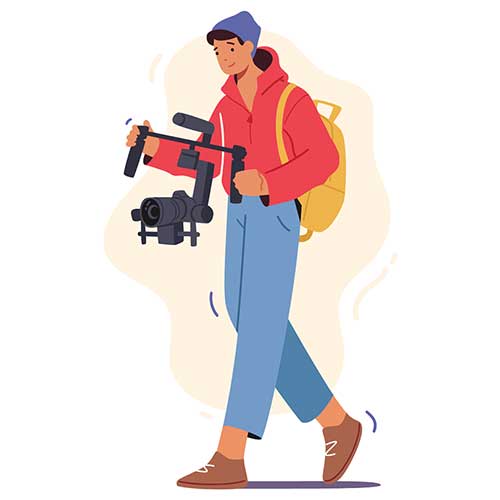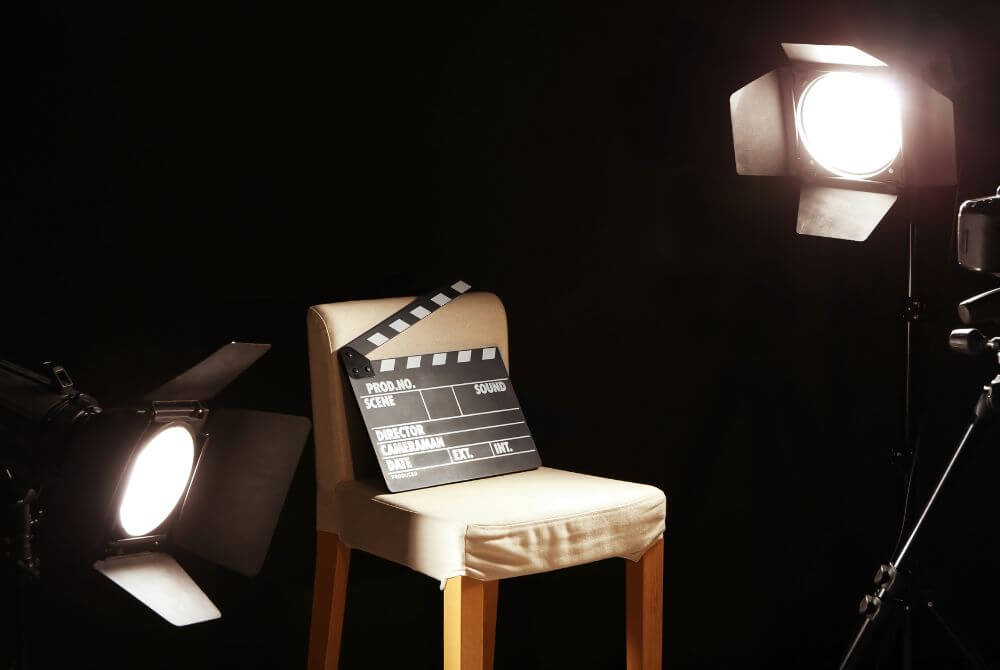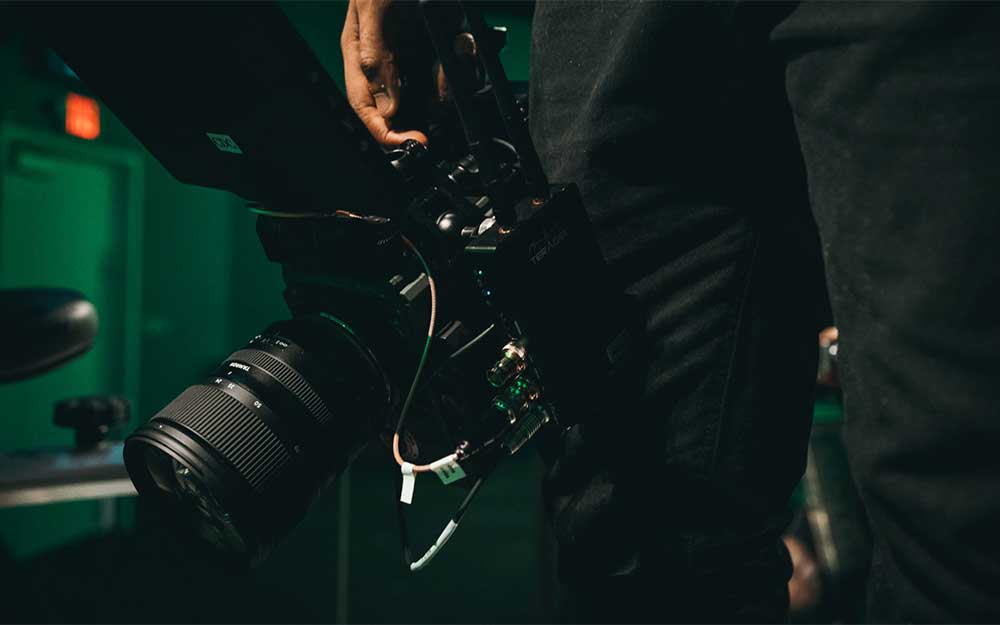Master In Cinematography Course
Get Corporate And Business Clients by enrolling our course
Trusted By 1000+ Students
Special Discount
With
FREE 8 Bonus Stuffs
Enroll today to Unlock Free Bonus Stuffs.


Overview Of Master In Cinematography Course
Hue N Rig Institute of Art & Design provides training for Master Cinematography Course in Mumbai. Master Cinematography course is programmed for students who hold a keen interest in the cinematic world and wish to make a career in this field. This course is designed to teach you all components of professional cinematography. In this Master Cinematography Training you will also learn about cinematic lighting, Camera movements, Equipment operation and advance editing techniques. This hands-on and practical experience helps to prepare for entry into wedding cinematic, industrial architecture and interior cinematic. Students can attend these Master Cinematography classes in Mumbai both online & offline classroom training. Please note this is not film directing course and has nothing to do with film industry. So if you want to build your career in Master Cinematography, Hue N Rig Institute of Art & Design is the best platform to get enroll

What will you learn from this course?
Key features of the course
- Fundamental of Cinematography
- Types of video light
- Types of shots
- Mastering angles
- Framing shots as per demand
- Principle of lens in cinematography
- Understanding Color Grading
- Operating DSLR Professionally
- Master mix Editing
- Audio Video Syncing
Unlock Bonuses FREE Stuffs On Enrollment
Hue N Rig Official App
Hue N Rig free app is where you will be provided free content, progress management, assignments etc.
Content & Learning Material
Free content like videos, notes and assessments will be provided to students to make them understand the subject better.
Stock Libraries
Complete guidance for stock libraries will be given to students to make work process fast and creative.
Practice Files
Students will be regularly provided with projects filers of the topics taught so that they can practice at home to master there skills.
Portfolio & Resume Building Lectures
After completion of course will personally guide students to build work portfolio and resume for future jobs and projects opportunities.
Artist Design Management Lectures
How graphic designer's should manage there work pipeline to beat delivery dates.
Confident Building Sessions
How to confidently talk to the client and crack the deal. Understanding client's requirements and reply them like professionals.
Practice on Live Projects
We will be providing live projects to students to make them understand industrial standards of designing and workflow.

Benefits after completing Master In Cinematography Course Training from Hue N Rig Institute Of Art & Design
- 100% creative growth
- Developing vision with creative perspective.
- Clearing job interview
- No more wasting time or money seeking other courses.
- Growing your own business.
- Building your own start-up company
- You can be a professional freelancer
Master In Cinematography Course Training Software
- Pre Shoot Planning
- Lighting Setup
- Camera Operation
- Shooting
- Framing
- Color Grading
- Premier
- After Effects
Hue N Rig Institute of Art & Design provides classroom training For Cinematography Course
Offline Classroom Practical Training
Where students will be provided training by faculty inside a classroom.
- It will be a face to face direct training.
- Training will be conducted in batch.
- You can directly interact with faculty in classroom for any queries.
Lecture types covered for this course will be in
- Software Technical
- Theoretical
- Practical
- Conceptual
- Project Based Training
- A professional certificated will be provided to the students after successfully completion of the course.
- Students should submit there projects and get it approved from the faculty.
- Within 15 Days of submission of project, institute will issue the certificate under name of student enrolled
Master In Cinematography Course Module
(45 Modules with 30+ Projects)
Introduction to Cinematography
Understanding the basics of cinematography is crucial as it forms the foundation for all other learning in this field. It introduces the essential concepts and responsibilities of a cinematographer, highlighting the importance of visual storytelling in creating engaging content.
Historical Overview
Learning about the history and evolution of cinematography helps students appreciate the technological and artistic advancements that have shaped the industry. It provides context and inspiration by exploring the work of pioneering cinematographers and significant milestones.
Technical Aspects
Technical knowledge is essential for making informed decisions during shooting. Understanding video standards, bit depth, pixel aspect ratios, and frame rates ensures high-quality footage and compatibility with various platforms and post-production processes.
Pre-Shoot Preparation
Effective pre-shoot preparation is vital for a smooth production process. This module emphasizes the importance of planning, organization, and collaboration, which are key to avoiding common pitfalls and ensuring a successful shoot.
Shoot/Edit Concept
Shooting with post-production in mind helps maintain continuity and streamline the editing process. This module teaches techniques to capture comprehensive coverage and plan for seamless transitions, reducing editing time and enhancing the final product.
Storyboarding
Storyboarding is a critical planning tool that helps visualize the narrative and plan shots effectively. It ensures a coherent visual story, facilitates communication with the team, and serves as a reference throughout the production process.
Types of Cinematic Cameras
Knowledge of different camera types and their features enables cinematographers to select the most suitable equipment for their projects. Understanding the strengths and limitations of each camera type ensures optimal performance and desired visual outcomes.
Camera Settings
Mastering camera settings is essential for controlling exposure, focus, and color balance. This knowledge allows cinematographers to adapt to various lighting conditions and achieve the desired visual effects, contributing to the overall quality of the footage.
Visual Storytelling
Visual storytelling is at the heart of cinematography. This module teaches how to use visual elements to convey emotions, themes, and narratives effectively, enhancing the audience's engagement and understanding of the content.
Types of Cinematic Shots
Different shot types serve specific narrative purposes and emotional impacts. Understanding these helps cinematographers choose the appropriate shots to tell the story effectively and keep the audience visually engaged.
Framing
Proper framing ensures that each shot is visually appealing and aligned with the narrative goals. Mastering framing techniques helps create balanced, dynamic compositions that guide the viewer's eye and enhance the storytelling.
Angle
Camera angles influence the perception of the subject and the emotional tone of the scene. This module highlights the significance of angle choices in conveying power dynamics, perspectives, and mood, adding depth to the storytelling.
Setting Up Scene & Continuity
Maintaining continuity is crucial for creating a seamless viewing experience. This module teaches how to set up scenes and ensure consistency in visual elements, preventing jarring transitions that can distract or confuse the audience.
Lights & Techniques
Lighting significantly affects the mood, texture, and clarity of a scene. Understanding various lighting techniques allows cinematographers to manipulate light creatively, enhancing the visual narrative and guiding the audience's emotional response.
Rules of Composition
Composition rules help create visually pleasing and impactful images. This module provides the tools to structure shots effectively, ensuring that each frame supports the narrative and engages the viewer.
Color Grading
Color grading is essential for setting the visual tone and mood of the footage. This module teaches how to manipulate colors to enhance the story, create consistency across scenes, and evoke specific emotional responses from the audience.
Lens Selection
Different lenses produce different visual effects. Understanding lens selection helps cinematographers choose the right lens for the desired depth, perspective, and focus, which is crucial for achieving the intended look and feel of the footage.
Camera Movement
Camera movement adds dynamism and helps tell the story in a more engaging way. Learning various movement techniques allows cinematographers to direct the viewer's attention, build tension, or create a sense of space and motion.
Stabilization Tools
Stabilization is critical for smooth, professional-looking footage. This module covers the tools and techniques to eliminate unwanted camera shake, ensuring that the footage is clear and steady, which is particularly important for dynamic shots.
Gimbals & Modes
Gimbals provide advanced stabilization and allow for fluid camera movements. Understanding the different gimbal modes and their applications enables cinematographers to capture smooth, cinematic shots in various scenarios.
Sound and Music in Cinematography
Sound and music are integral to the cinematic experience. This module emphasizes the role of audio in storytelling, teaching how to capture and design sound effectively, sync audio with visuals, and use music to enhance emotional impact.
How to Capture Weddings (Part 1)
Capturing weddings requires a unique set of skills to document a significant event creatively and respectfully. This module covers techniques for shooting various aspects of weddings, ensuring comprehensive and beautiful coverage.
How to Capture Weddings (Part 2)
Building on the first part, this module delves into advanced techniques for wedding cinematography. It covers capturing intimate moments, managing different lighting conditions, and tips for post-production to create a polished final product.
How to Shoot Offices
Shooting in office environments presents unique challenges. This module provides techniques for capturing interviews, meetings, and office activities, focusing on composition, lighting, and sound recording in confined spaces.
How to Shoot Behind the Scenes
Behind-the-scenes footage offers valuable insights and additional content for viewers. This module teaches how to document the production process, capturing candid moments and interactions to create engaging behind-the-scenes videos.
How to Shoot Social Media Video Professionally
Social media requires a different approach to video production. This module covers the formats, techniques, and strategies for creating high-quality social media videos that are engaging and optimized for various platforms.
How to Shoot Chroma Video
Chroma keying (green screen) allows for creative background replacements. This module teaches the setup and lighting techniques necessary for successful chroma keying, enabling the creation of visually compelling content.
How to Shoot YouTube Video
YouTube has specific requirements for successful content. This module covers planning, scripting, shooting, and editing techniques tailored to YouTube, helping creators produce high-quality, engaging videos that attract and retain viewers.
Multicam Shoot
Multicam shoots offer a dynamic way to capture events from multiple angles. This module teaches how to set up and synchronize multiple cameras, manage different angles, and edit multicam footage efficiently.
Adobe Premiere Pro
Adobe Premiere Pro is a powerful, industry-standard video editing software. You can learn to seamlessly edit footage, add special effects, enhance audio, and produce professional-quality videos. Mastering Premiere Pro is essential for anyone aiming for excellence in video production.
Adobe After Effects
Adobe After Effects is essential for creating motion graphics and visual effects. You can learn to design animations, composite elements, and enhance videos with advanced effects. Mastering After Effects is crucial for producing professional-quality visual content in the media industry.
Download Our FREE APP Now
Enroll now and get certified for Master In Cinematography in Mumbai by Hue N Rig Institute Of Art & Design






EXCELLENTTrustindex verifies that the original source of the review is Google. My name is Sandeep Rahate and I am an interior designing student. My overall experience with my designer course is very satisfying. My "Autocad" and "Photoshop" classes were very good. Online and offline classes experience was also very good. They give attension to each and every student. I am satisfised by the way the teachTrustindex verifies that the original source of the review is Google. I had a great time doing graphic designing course and everyone involved in the Hue&Rig institute has made it a great experience. I look forward doing more courses with you guys in the future and have been recommending you to everyone I know. Thank youTrustindex verifies that the original source of the review is Google. I am a student of hue n rig. I have just completed one month in online classes.all of you are also getting our support in online classes.thanks for your support sir n missTrustindex verifies that the original source of the review is Google. Hue n rigs have great teachers and guides who are available 24 x7 for any help. I have learnt a great deal from the graphic design ing course, and although in lockdown have succeeded in conducting lectures. It was very homely too n the workspace is ideal. Thanks to the sirs and teachers to taught with dedication n respect.All the best. May you grow to greater heightsTrustindex verifies that the original source of the review is Google. I Mr.Pratiek Veluthamannunkal Student of Hue & Rig like to mention online classes are very good during lockdown period as we do not have to carry sanitzer & mask during our travel for lectures at the same time classroom lectures excellent because during lectures our doubts can be cleared then and there. No Doubt our faculty take lectures online and in class the way the student understand . But we miss our faculty as we can't communicate personally. (But on Phone they are available to clear our doubts)Trustindex verifies that the original source of the review is Google. I am a student of Hue N Rig. I have just completed one month.I am having a good experience with them, the trainers are helpful, supportive and friendly,It help us to create new things.thanks for your support.
Decide Soon?
Still confused about joining. Get in touch with our team
Want To Know More About Our
Master In Cinematography Course?
Why Learn Master In Cinematography Course From Hue N Rig?
Affordable & Flexible Fees Structure
All Certified Training Program
10+ Years Experienced Trainers
Practical & Conceptual Training
Regular Assignments & Monitoring
Modern techniques of learning
Interactive Group Discussion Session
Q & A Problem Solving Session
Career After Cinematography Documentary Video Freelance Cinematographer Ads Shoot Music Videos Shoot Screenplay Story Boarding Video Color Grading Pre-Wedding Cinematic Wedding Cinematic
FREQUENTLY ASKED QUESTION FOR CINEMATOGRAPHY COURSES IN MUMBAI
Essential skill for Cinematography are :
- Visual Storytelling
- Strong Communication to convey
- Excellent understanding to represent visually
As they convey their work through Visual stories.
We Have two types of Diploma courses in Cinematography one is Wedding Cinematography Course duration 5 months & other is Master in Cinematography Course duration 8 months.
Cinematography covers: Lighting, framing, composition, camera movement, camera angle, video selection, lens options, depth of field, zoom, focus, color, exposure and filtering.
Cinematography is pursued by the students to develop excellent intellectual, communication, writing skills directly related to cinematography, wedding cinematic, pre weddings, web series, commercial, industrial and lots more.
Yes! With our Diploma courses in Cinematography you can learn part time.
Yes, Sound is the heart of Cinematography.
Being technical is great as a cinematographer, but having a vision is the most important thing, as the role of a cinematographer is both technical and creative.
The gaffer is the lead lighting technician on set and head of the electrical department, while the cinematographer is responsible for the camera and lighting equipment to create the look.
Career Options in Cinematography :
Director of Photography, Video Editor, Cinematographer, Cameraman, Videographer, Freelancer, Video Assistant many more.
Cinematography is the art and craft of making visuals by capturing a story with a camera and light.
NO.
Cinematographer is the person responsible for creating the look and feel, color, lighting, and framing of each shot in a frame.
We provide both live online & offline classroom training.
Offline classroom training gives u an extra facility to communicate and interact with faculty on the spot if there is some doubt. Also there is always a plus point of classroom training over recorded lectures
